Monroe, Michigan’s Civil War Connections
Located along Lake Erie’s western shore, about midway between Detroit, Michigan and Toledo, Ohio, Monroe, Michigan was the scene of numerous events during the War of 1812. Today they are commemorated at River Raisin National Battlefield Park.
Two battles were fought here in 1813, and armies passed through the region numerous times during the conflict. Yet the town has strong Civil War connections as well. Monroe was the home of Gen. George Custer, and is a source of pride for the community. Yet digging deeper there is even more Civil War history here.
Located along one of the main streets in downtown stands an impressive equestrian monument to Custer. A nearby historic marker highlights his life and career. The general looms large here.
George Custer and Elizabeth (Libby) Bacon were married in the Presbyterian Church on the town square. The Monroe County Museum has many Custer items on display, including uniforms, weapons, and personal items of George and Libby, as well as on George’s two brothers Tom and Boston. George and Libby rest in the cemetery at West Point, but in Monroe’s Woodland Cemetery is the Custer family plot with Boston (who was killed at Little Bighorn). Tom is in Fort Leavenworth National Cemetery.
Yet there is much more beyond General Custer. A historic marker in town notes that Monroe County had the highest portion of enlistment in the Union army during the war.
Historic marker notes’ the town’s contributions to the Union army.
An impressive monument stands along the waterfront honoring the town’s Civil War soldiers and its Medal of Honor recipients. The monument lists the name of every single soldier from the community.
Monument in Monroe’s waterfront.
The monument also honors the eight men from Monroe County who earned the Medal of Honor during the war. Their stories are, briefly:
First Lieutenant James Christancy with the 9th Michigan Cavalry. As an aide, he voluntarily led a group in the battle of Haw’s Shop, near Cold Harbor, VA, in May, 1864, and was wounded twice.
Second Lieutenant Thomas Custer, younger brother of George. At Sailor’s Creek he leaped his horse over Confederate earthworks, captured two flags, and was wounded.
Private Frederick Ballen. Serving in the 47th Ohio, he volunteered to serve on board a barge loaded with supplies that ran past Confederate batteries on the Mississippi River.
Sergeant Daniel McFall, 17th Michigan. At Spotsylvania on May 12, 1864, he captured Colonel Barker, a Confederate brigade commander, and rescued a Union officer from the enemy.
Henry Peters, Private, 47th Ohio. He served in the same action as Ballen.
Julius Rhodes. While serving with the 5th New York Cavalry, he has his horse shot from under him at Thoroughfare Gap. He then voluntarily joined the 105th New York and fought with them at Second Manassas, displaying gallantry.
Charles Sancrainte. This private in the 15th Michigan captured the flag of the 5th Texas during the battle of Atlanta.
Peter Sype. Serving with the 47th Ohio, he was in the same action as Ballen and Peters.
The monument highlights those who earned the Medal of Honor.
These eight men, serving in different theaters and in various branches, earned the medal for a variety of actions. Several other local units and soldiers are honored here. Organized in Monroe, the 7th Michigan fought through the streets of Fredericksburg prior to the main assault on December 13, 1862. Leading the unit across the Rappahannock River and through the town was Norman Hall.
Hall was serving in the garrison at Fort Sumter when Confederates opened fire in April, 1861. Hall transferred to command the 7th Michigan, seeing action at Second Manassas, Antietam, Fredericksburg, and Gettysburg, where his troops were near the angle during Pickett’s Charge.
Hall’s career is highlighted on one part of the monument.
After the war Union veterans organized the Grand Army of the Republic (G.A.R.) and nine chapters were founded in Monroe County- nine! This veterans group lobbied for benefits for the disabled as well as for widows and orphans. It is not surprising that Monroe County had such a strong G.A.R. presence.
Marker about the G.A.R. in Monroe.
Although hundreds of miles from the battlefields, the Civil War looms large in memory in Monroe, Michigan. And while General Custer is a local hero who stands, literally, tall in this town, there are so many more Civil War connections.
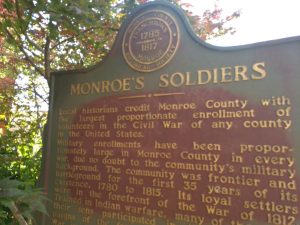
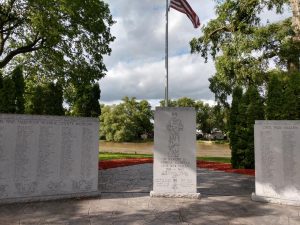
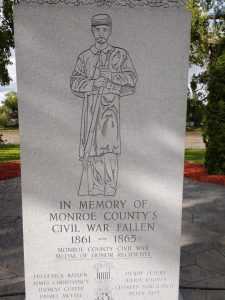
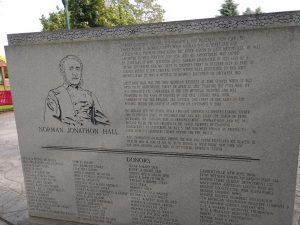
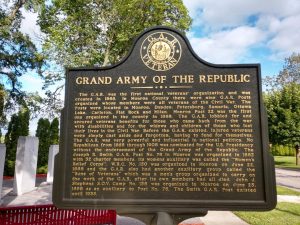
Camp Monroe was a place just north of the River Raisin situated on 20 acres where soldiers lived and trained in 1861 and 1862. A small building on the property once served as a regimental Headquarters.
Recruits came from communities near and far, including Port Huron, Mason, Jonesville, Monroe, Lapeer, Pontiac.
Camp Monroe now has a historical marker recognizing the significance of the area. The marker, which is located in the 400 block of St. Mary?s Ave. south of W. Lorain St.
The camp contained a large fair building in the center, which served as the quartermaster?s department, a mess tent with a kitchen and tents for the soldiers.
Michigan’s 7th Cavalry, the 15th Michigan Infantry and the 1st Michigan Light Artillery, Battery H, trained at the camp .
Camp Monroe had General Armstrong Custer Brigadier General Henry Baxter who was a capt. at Camp Monroe ,Colonel John Oliver , Colonel Norman Hall , Thomas Custer of Monroe county was the Highest decorated union soldier in the civil war and was the first two time recipient of the medal of Honor. Many Soldiers from Monroe were on the steam boat the sultana disaster more lives were lost on the sultana than the titanic ship ! many Monroe Soldiers Did survive.
Due to his military experience, Baxter was elected captain of a local company at Camp Monroe (Monroe MI today at the fair grounds) which was to be designated as Camp Monroe, Parts of five companies,being one from Port Huron under Capt. Hunt, from Jonesville under Capt. Baxter, from Burr Oak under Capt. Waterman, from Farmington under Capt. Harty, and the Monroe City Guards under Capt. Darrah have been reported at the Camp, partially full. ) that became Company C of the 7th Michigan Infantry Regiment.
At the Battle of Gettysburg, his brigade resisted a Confederate assault from parts of Maj. Gen. Robert E. Rodes’s division, slaughtering hundreds in a surprise attack on BG Alfred Iverson’s brigade, and held the north flank of the Union position for much of the day before retiring due to lack of ammunition. He was wounded four times during the war. He later served as President Grant’s Minister to Honduras.